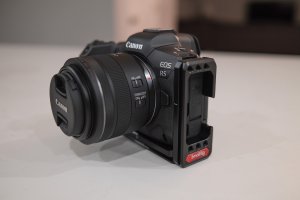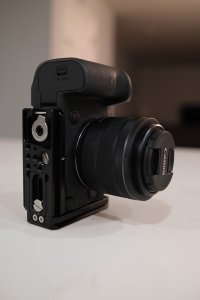My take is:
Canon EF adapter with control ring. The few bucks saved doesn't inspire confidence to go third party on an adapter. I'd prefer to know my weather sealing is guaranteed, lens communication tested with tons of lenses, etc. The control ring can be anything from ISO, aperture, compensation. It is super useful. For 99 bucks you are adding a well placed control to any EF glass.
You do not need pricy cards unless you are shooting high bitrate video. I can shoot everything but 8K and 4K120 with the same Samsung 128GB SD cards I've been buying for a couple years. If you have the use case, any major brand with sufficient read/write speeds should work. I wouldn't go with people's brand suggestions, I would go with charts and bitrate calculations or Canon approved cards. The manual has some advice in this regard I believe.
Battery grip? Again what is your use case? If you don't want to carry a set of spare batteries or have a use where you don't have time to change, you might need one. I cannot stand them and never buy them. I don't plan on wasting money on LP-E6NH either. This is a place where Canon and other camera companies are truly evil: 70 dollars for a tiny battery? High quality battery banks with short circuit protection, etc. are cheaper. Have been shooting with half genuine Canon LP-E6N or LP-E6 for years, along with Wasabi or other made Japan made off brand equivalents. For serious work like night timelapse or motion control, I use large 12V battery banks, a voltage converter, and a dummy battery.
I see others mentioning filters and I must say- definitely don't use cheap or free ones if you bother. Also, screw on ones are annoying. I used to buy expensive screw on UV filters, ND, and CPL, until I realized circular filters are not flexible, are a pain and way over priced, vignette unless you buy low profile, vignette if stacked, and a lens hood will always work better at protection than a thin piece of glass anyway. Have had zero problems with scratches, damage, or keeping glass clean. Modernlenses are durable, and plus a lens cap should always be on when not shooting. I now use 100mm x 150mm filters with a Haida holder. Similar prices for good filter glass that is thicker, graduated filters are actually useful since they can be rotated and moved up or down for horizons or other positioning, and stacking them or installing CPL / ND is much easier. Using square filters means one set fits many lens sizes too, like 82mm/77mm and smaller. Much faster to remove a stack of filters with one button press than dorking with screw on filters in the cold or beach or wherever. If you buy the inexpensive holder ring for each lens, you can swap filters from one lens to the next in seconds without buying multiple sets.



